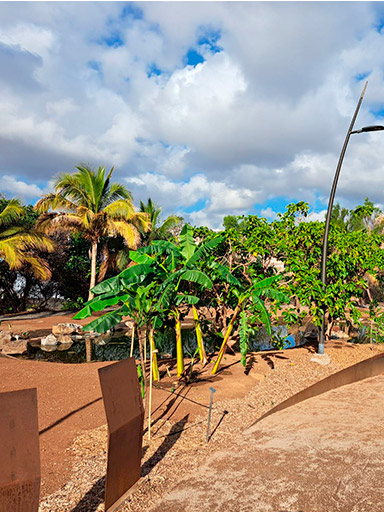- Fundación Moeve collaborated on the project, which expands the area open to visitors and strengthens the biodiversity of this botanical garden
- The grand opening was one of the activities planned to celebrate its 10th anniversary
“To commemorate the 10th anniversary of the Palmetum, the botanical miracle of the Canary Islands, we’ll also present a week-long program of activities today,” Bermúdez announced. "Furthermore, after this opening ceremony, a new space devoted to Papua New Guinea will be launched at the Palmetum with breadfruit trees, dwarf coconut trees, and 58 other plant species, as well as a hut for birdwatching in its lagoon,” he added.
"This botanical garden, which is one of a kind in Europe, was built on a former landfill that closed in 1984. After the project was planned and approved in 1996, construction began, and it opened to the public in 2014. We’re therefore celebrating its first decade this year," the mayor explained. “The Palmetum, as it is known both at home and abroad, has approximately 2,000 plant species, including 500 palm trees, which explains its uniqueness and appeal to so many residents, visitors, and tourists,” Bermúdez added.
“It’s an honor to witness such an important milestone, the 10th anniversary of this beautiful botanical garden, the Palmetum," said Belén Machado, head of Fundación Moeve in the Canary Islands, in her speech. The site "is both a symbol of environmental recovery and sustainability and an inspiring example of how nature and community can thrive together by following a joint path, one that has led to its transformation into a space teeming with biodiversity."
“We have the privilege of taking part, as committed collaborators, in the conservation and recovery of biodiversity and also in improving quality of life for people, two things that an environment like this can definitely bring together,” she added. “We are eager to continue collaborating on projects that connect citizens with nature, strengthening biodiversity and promoting sustainable development. The Palmetum is a great example; it’s not just another botanical garden, but a testimony of transformation as a former landfill turned into an oasis of life."
Carlos Tarife pointed out that the Palmetum belongs to Botanic Gardens Conservation International (BGCI) and the Ibero-Macaronesian Association of Botanical Gardens (AIMJB). "We comply with the international requirements for all botanical gardens, with a collection of species documented with scientific rigor, many of them endangered or already extinct in their place of origin,” he said. "For this reason, we are certified as an organization that contributes to the conservation of biodiversity, as well as to research and teaching to develop environmental education and research projects.”
Meanwhile, Javier Rivero, councilor for the Maritime Park and Palmetum, highlighted that "over the past 10 years, the Palmetum has received 550,000 visitors. We can say that it’s at its finest moment since it opened, and proof of this is that we're going to hold another Meeting of Botanical Gardens of the Canary Islands this week, on December 12th and 13th. And since we remain committed to encouraging visits from the residents of Santa Cruz, this week we have organized guided tours for them, so that they experience this unique, emblematic space of the city's transformation as their own. This week, we’ll also welcome a group of agriculture and gardening students, so they can enjoy hands-on learning in this immense and diverse botanical garden, filled with species from almost every corner of the planet.”
New birdwatching area
The new area devoted to Papua New Guinea represents an improvement for the bird life of the Palmetum botanical garden, expanding the space available for birds with new places to feed and nest. Also, the new lake in this area is a must-visit spot for birds to rest and quench their thirst, and in some cases, even to reproduce in a short period of time.
After today's grand opening, the slow and gradual process of developing vegetation will begin, especially in the area around the lake. This means that a growing number of birds will be seen on its shores, as it becomes an ideal place for them with more spots for shelter and protection, just like the other lakes in the park. Doves, partridges, blackbirds, and canaries are already visiting the spot at different times of day, but over time, many more will be seen.
Using the hide or birdwatching point, people will be able to observe them in the best possible conditions and without disturbing them. There are now 94 different species of birds in the Palmetum botanical garden, including aquatic ones that nest in the lakes and have begun to frequent this new wetland in what is known as the Papua New Guinea area. Such has been the case of the first moorhens, wagtails, and even some wintering egrets.
There are local birds that visit these little oases as their main places to drink and rest, but migratory birds also come to them, either making a recovery stop on their journeys, or settling for the winter until they return to their breeding areas in the spring.

